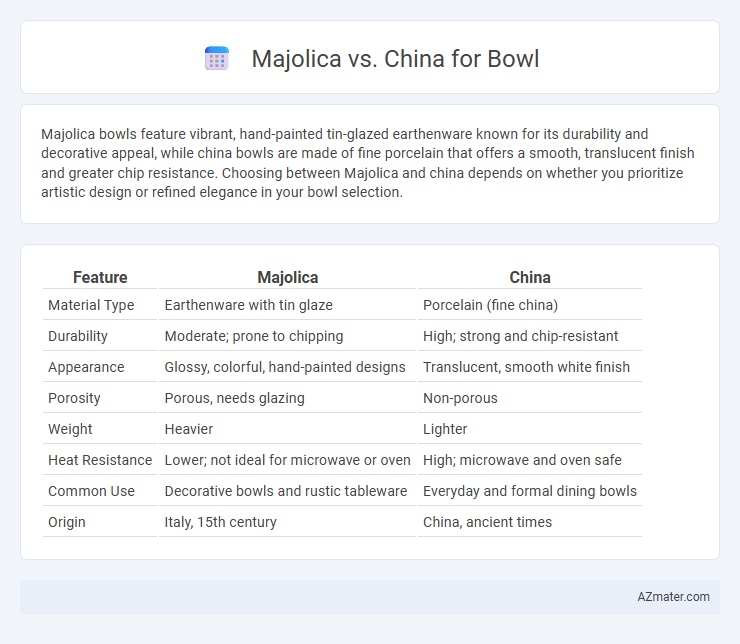Majolica bowls feature vibrant, hand-painted tin-glazed earthenware known for its durability and decorative appeal, while china bowls are made of fine porcelain that offers a smooth, translucent finish and greater chip resistance. Choosing between Majolica and china depends on whether you prioritize artistic design or refined elegance in your bowl selection.
Table of Comparison
| Feature | Majolica | China |
|---|---|---|
| Material Type | Earthenware with tin glaze | Porcelain (fine china) |
| Durability | Moderate; prone to chipping | High; strong and chip-resistant |
| Appearance | Glossy, colorful, hand-painted designs | Translucent, smooth white finish |
| Porosity | Porous, needs glazing | Non-porous |
| Weight | Heavier | Lighter |
| Heat Resistance | Lower; not ideal for microwave or oven | High; microwave and oven safe |
| Common Use | Decorative bowls and rustic tableware | Everyday and formal dining bowls |
| Origin | Italy, 15th century | China, ancient times |
Introduction to Majolica and China Bowls
Majolica bowls are ceramic pieces characterized by their vibrant, hand-painted glazes and intricate patterns, originating from Renaissance Italy and renowned for their decorative appeal. China bowls, typically made from fine porcelain or bone china, are prized for their durability, translucent quality, and classic elegance often adorned with delicate designs or simple white finishes. Both types of bowls serve distinct purposes in tableware collections, combining functionality with unique artistic and cultural significance.
Historical Background and Origins
Majolica, originating in the Renaissance period of 15th-century Italy, is a tin-glazed pottery noted for its vibrant, intricate designs and opaque white surface that allowed detailed painting. In contrast, China porcelain dates back to the Tang dynasty (618-907 AD), evolving through centuries into highly refined, translucent ceramics prized for their durability and delicate blue-and-white motifs. While Majolica reflects European artistic revival influences with its colorful, rustic appeal, Chinese porcelain embodies advanced kiln technology and cultural symbolism central to East Asian heritage.
Material Composition and Craftsmanship
Majolica bowls are crafted from earthenware clay, characterized by a porous body coated with a tin-based glaze that creates a vibrant, opaque surface, while China bowls are typically made from refined kaolin clay, resulting in a dense, non-porous porcelain known for its translucency and durability. Majolica's craftsmanship involves hand-painting intricate, colorful designs before glazing, highlighting artisanal techniques rooted in Renaissance Italy, whereas China bowls emphasize precision in wheel-throwing or molding and glazing, reflecting centuries of advanced ceramic technology. The distinct material compositions influence Majolica's rustic, decorative appeal contrasted with China's elegant, minimalist finish favored for formal dining.
Design Styles and Aesthetic Appeal
Majolica bowls showcase vibrant, hand-painted designs featuring bold colors and intricate floral or natural motifs, embodying a rustic and artisanal charm. In contrast, China bowls often present refined, delicate patterns with smooth, glossy finishes and subtle detailing, exuding elegance and sophistication. The aesthetic appeal of Majolica lies in its expressive, textured surfaces, while China is prized for its sleek, timeless beauty and fine craftsmanship.
Durability and Practical Use
Majolica bowls are known for their vibrant glaze and decorative appeal but tend to be more porous and less resistant to chipping compared to fine china, affecting their long-term durability. China bowls, crafted from high-quality porcelain, offer exceptional strength, chip resistance, and non-porous surfaces, making them more practical for everyday use and frequent washing. While majolica excels in aesthetic charm, china provides superior functionality and durability for regular kitchen use.
Cost Comparison: Affordability and Value
Majolica bowls typically offer greater affordability due to their artisanal production methods and use of local, less expensive materials, making them a cost-effective choice for decorative and functional tableware. In contrast, genuine China bowls, often crafted from fine porcelain with intricate glazing, command higher prices reflecting superior durability and prestige, providing long-term value despite the initial investment. Consumers seeking budget-friendly options may favor Majolica for its artistic charm and lower cost, while those prioritizing investment in timeless quality might prefer China bowls for their resilience and classic appeal.
Collectibility and Market Demand
Majolica bowls, renowned for their vibrant, hand-painted glazes and intricate designs, command higher collectibility due to their artistic uniqueness and historical significance dating back to the Renaissance. China bowls, typically made from fine porcelain with delicate patterns, are valued for their craftsmanship and association with prestigious manufacturers like Limoges or Wedgwood, attracting collectors seeking classic elegance. Market demand favors Majolica among antique enthusiasts interested in decorative, eye-catching pieces, while China bowls appeal to collectors prioritizing refined, traditional tableware.
Cleaning and Maintenance Requirements
Majolica bowls require gentle hand washing with mild soap to preserve their vibrant glazes and intricate patterns, avoiding abrasive scrubbers that can damage the surface. China bowls, often dishwasher-safe, allow more straightforward cleaning but may develop fine cracks or fade if subjected to harsh detergents or high heat repeatedly. Proper maintenance of Majolica involves careful handling and occasional sealing of unglazed areas, while China benefits from routine dishwasher use paired with delicate care to extend its lifespan.
Popular Brands and Manufacturers
Majolica bowls are prominently produced by brands like Bordallo Pinheiro and Villeroy & Boch, known for their vibrant, hand-painted earthenware designs that combine artistic tradition with durability. In contrast, fine china bowls are often crafted by established manufacturers such as Royal Doulton and Wedgwood, celebrated for their elegant, translucent porcelain and intricate patterns ideal for formal dining settings. Both categories emphasize quality craftsmanship, but Majolica highlights colorful, rustic appeal, while china focuses on refined aesthetics and delicate finishes.
Choosing Between Majolica and China for Your Bowl
Choosing between Majolica and China for your bowl depends on durability and aesthetic preferences. Majolica offers vibrant, hand-painted designs with a rustic charm, often made from earthenware that is less chip-resistant. China, typically porcelain, provides a sleek, durable, and non-porous option ideal for everyday use and formal settings.

Infographic: Majolica vs China for Bowl
 azmater.com
azmater.com